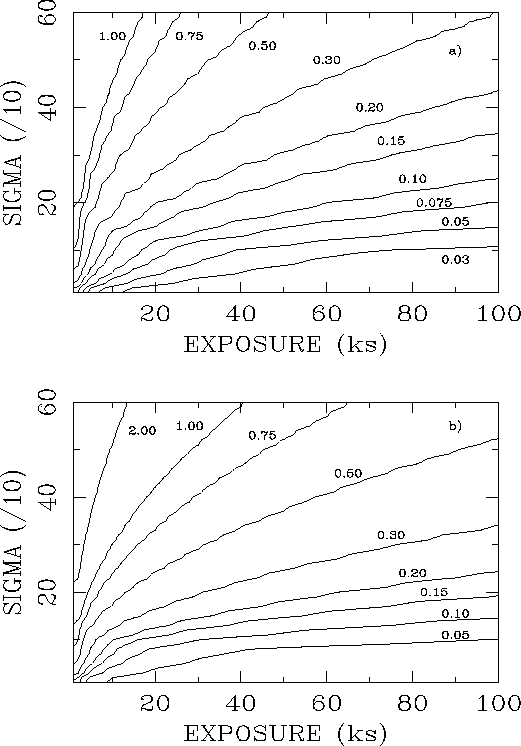| About ROSAT |
ROSAT Home Page | ROSAT Images |
|---|
The typical HRI background in on-axis detection cells
( ![]() ) is of order unity or lower for most HRI
observations (
) is of order unity or lower for most HRI
observations ( ![]() ks), and therefore in the range
where Poisson statistics are appropriate for source-detection analysis.
For example, the number of background counts expected in a
detection cell for a 20 ks observation is 0.55.
A
ks), and therefore in the range
where Poisson statistics are appropriate for source-detection analysis.
For example, the number of background counts expected in a
detection cell for a 20 ks observation is 0.55.
A ![]() detection of a source using Poissonian statistics
would then require 7 counts, for a count rate of
detection of a source using Poissonian statistics
would then require 7 counts, for a count rate of
![]() counts s
counts s ![]() in the detection cell,
a total count rate of
in the detection cell,
a total count rate of ![]() counts s
counts s ![]() .
The count rate of the source, however, is known to less than
.
The count rate of the source, however, is known to less than ![]() .
In lieu of an analytic function (of which none exists),
Fig. 5.23a
displays a contour plot of limiting (total) count rate for a
source detection on a grid of significance (sigma) and exposure.
The plot was generated for the on-axis detection cell and
assumes the nominal background rate.
Figure 5.23b
shows the same information for a region of interest 10' off axis
where the detection cell is
.
In lieu of an analytic function (of which none exists),
Fig. 5.23a
displays a contour plot of limiting (total) count rate for a
source detection on a grid of significance (sigma) and exposure.
The plot was generated for the on-axis detection cell and
assumes the nominal background rate.
Figure 5.23b
shows the same information for a region of interest 10' off axis
where the detection cell is ![]() and the background
count rate
and the background
count rate ![]() counts s
counts s ![]() .
Off axis, the same considerations of vignetting correction and
larger detection cells as for the Gaussian case must be taken.
The conversion between count rate and flux is the same as above.
.
Off axis, the same considerations of vignetting correction and
larger detection cells as for the Gaussian case must be taken.
The conversion between count rate and flux is the same as above.

Figure 5.23: The relation between source count rate, statistical significance,
and exposure for an HRI observation using Poisson statistics
is shown. The contour plots show the source count rate in
units of ![]() counts s
counts s ![]() versus exposure in ks
and sigma (a value for
versus exposure in ks
and sigma (a value for ![]() of 50 refers to 5
of 50 refers to 5 ![]() ).
Plot a) is for the on-axis case, plot b) is for 10' off axis.
).
Plot a) is for the on-axis case, plot b) is for 10' off axis.